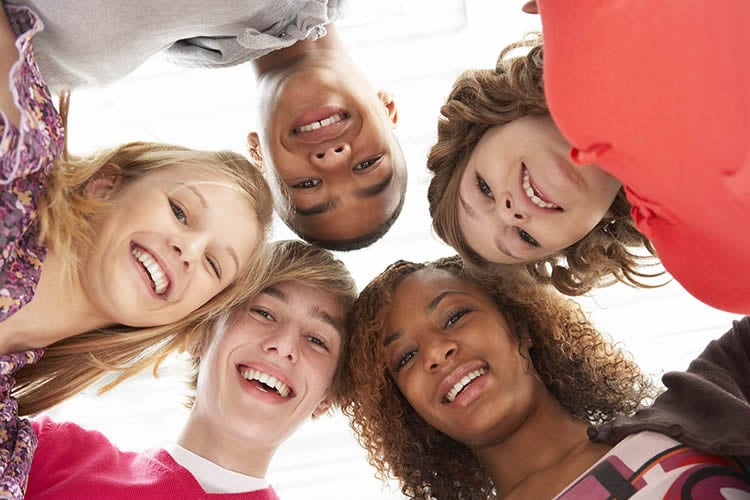Summary: According to researchers, adolescents start to view faces differently as they transition into adulthood.
Source: Penn State.
Faces are as unique as fingerprints and can reveal a great deal of information about our health, personalities, age, and feelings. Penn State researchers recently discovered adolescents begin to view faces differently as they prepare for the transition to adulthood.
Suzy Scherf, assistant professor of psychology and head of the Laboratory of Developmental Neuroscience at Penn State, and Giorgia Picci, graduate student in developmental psychology, published their findings recently in the journal Psychological Science. “We know that faces convey a lot of different social information, and the ability to perceive and interpret this information changes through development,” Scherf explained. “For the first time, we’ve been able to show how puberty, not age, shapes our ability to recognize faces as we grow into adults.”
According to Scherf, the ability of adolescents to retune their face processing system, from showing a bias toward adult female faces as children, to preferring peer faces that match their own developmental stage in puberty, is part of the social metamorphosis that prepares them to take on adult social roles. “In other words, it literally changes the way people see faces. This has been shown previously in research published in animal literature, but not in humans.”
The researchers developed an innovative experimental design that proves a bias to remember peer faces is reflected in the pubertal stage of the face, rather than the age of the face, which is how previous researchers investigated these biases. “We were able to show that puberty shapes the subtle emergence of social behaviors that are important for adolescents’ transition to adulthood. This likely happens due to hormones influencing the brain and the nervous system reorganization that occurs during this time,” said Scherf.
The researchers recruited 116 adolescents and young adults for the study and separated them into four pubertal groups depending on their stage of puberty. Importantly, the adolescents in the study were all the same age, but differed in their stage of puberty. Therefore, any differences in the way they responded to faces were related to their pubertal status, not their age. Scherf and Picci determined the adolescents’ stage of development through self-assessments as well as parent-provided assessments.
The researchers presented participants with 120 gray-scale photographs of male and female faces. The pubertal status of the faces in the pictures matched that of the participants. “In other words, there were images of pre-pubescent children, young adolescents in early puberty, young adolescents in later puberty, and sexually mature young adults,” Scherf explained.
Participants were asked to look at faces from all four pubertal groups, and the researchers measured their face-recognition ability using a computerized game. After studying 10 target faces with neutral expressions, participants were shown another set of 20 faces with happy expressions and had to identify whether they had seen each face previously or if they were new.

Scherf and Picci found that the pre-pubescent children had a bias to remember adult faces, which they call the caregiver bias. “This is interesting because these are school-age children who spend lots of time with other children, yet they are still biased to remember adult faces,” said Scherf.
In contrast, adolescents had a bias to remember other adolescent faces, exhibiting a peer bias. According to Scherf, the most surprising finding was that among adolescents who were the same age, those who were less mature in pubertal development had better recognition memory for other similarly less mature adolescents, while those who were more mature in pubertal development had better recognition memory for peers who were similar in their level of development.
“This shows that adolescents are very clued into each other’s pubertal status. They can literally see it in each other’s faces, perhaps implicitly, and this influences how they keep track of each other. This may explain a well-known finding that adolescents organize their peer groups according to pubertal status and is relevant for understanding how adolescents begin to think about each other as romantic partners for the first time.”
This research will help scientists uncover how puberty impacts the developing human brain and help them understand the timetable of behavioral and brain changes during adolescence, which could guide mental health treatment and inform public health policy. In the future, Scherf and Picci plan to further investigate face processing changes that occur during puberty.
Funding: Scherf is one of 37 co-funded faculty members at Penn State’s Social Science Research Institute (SSRI). Support for this project was provided by SSRI, Penn State’s Department of Psychology, and the National Science Foundation Graduate Research Fellowship, which was awarded to Picci.
Source: Kristie Auman-Bauer – Penn State
Image Source: NeuroscienceNews.com image is adapted from the Penn State press release.
Original Research: Abstract for “From Caregivers to Peers: Puberty Shapes Human Face Perception” by Giorgia Picci and K. Suzanne Scherf in Psychological Science. Published online September 22 2016 doi:10.1177/0956797616663142
[cbtabs][cbtab title=”MLA”]Penn State. “Puberty Changes Facial Recognition.” NeuroscienceNews. NeuroscienceNews, 28 September 2016.
<https://neurosciencenews.com/facial-recognition-puberty-5144/>.[/cbtab][cbtab title=”APA”]Penn State. (2016, September 28). Puberty Changes Facial Recognition. NeuroscienceNew. Retrieved September 28, 2016 from https://neurosciencenews.com/facial-recognition-puberty-5144/[/cbtab][cbtab title=”Chicago”]Penn State. “Puberty Changes Facial Recognition.” https://neurosciencenews.com/facial-recognition-puberty-5144/ (accessed September 28, 2016).[/cbtab][/cbtabs]
Abstract
From Caregivers to Peers: Puberty Shapes Human Face Perception
Puberty prepares mammals to sexually reproduce during adolescence. It is also hypothesized to invoke a social metamorphosis that prepares adolescents to take on adult social roles. We provide the first evidence to support this hypothesis in humans and show that pubertal development retunes the face-processing system from a caregiver bias to a peer bias. Prior to puberty, children exhibit enhanced recognition for adult female faces. With puberty, superior recognition emerges for peer faces that match one’s pubertal status. As puberty progresses, so does the peer recognition bias. Adolescents become better at recognizing faces with a pubertal status similar to their own. These findings reconceptualize the adolescent “dip” in face recognition by showing that it is a recalibration of the face-processing system away from caregivers toward peers. Thus, in addition to preparing the physical body for sexual reproduction, puberty shapes the perceptual system for processing the social world in new ways.
“From Caregivers to Peers: Puberty Shapes Human Face Perception” by Giorgia Picci and K. Suzanne Scherf in Psychological Science. Published online September 22 2016 doi:10.1177/0956797616663142






